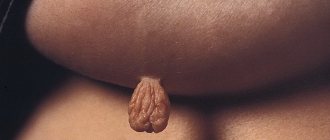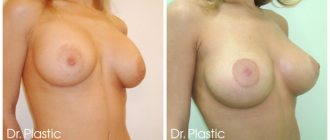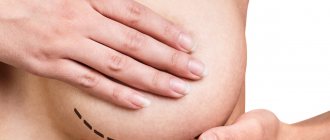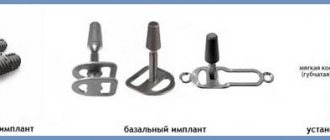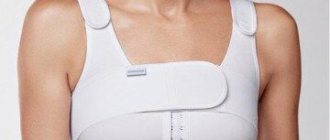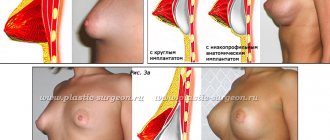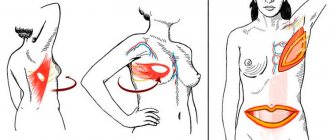The desire for an ideal appearance and getting rid of complexes can hit your pocket hard. However, all the money spent is worth it to overcome shortcomings and become more self-confident. We talk about the most expensive plastic surgeries.
Otari Gogiberidze
, plastic surgeon, founder of the Beauty Time clinic
Capsular contracture
By sewing implants into a woman’s breast, the surgeon essentially introduces a foreign body into her body, and the reaction to it cannot always be predicted. Sometimes scar tissue grows around the implant, and it appears as if enclosed in a dense bag. In this way, the body tries to distinguish “foreign” from its own tissues.
This condition is called capsular contracture and is one of the most common complications of breast augmentation surgery. Why it happens to some women and not to others - even scientists cannot answer this question.
Scar tissue prevents the implant from moving naturally. The chest becomes deformed and pain may occur.
There are four stages of capsular contracture:
- I - minor changes, when the breast looks normal, the implant is in place, and moves relatively easily.
- II - the breast has a normal shape, but is a little dense to the touch;
- III - the breast is deformed, the implant is displaced, shifted upward or to the other side, a lump is palpable;
- IV - symptoms are the same as in the third stage, but are even more pronounced.
Scar tissue can be seen on breast X-rays.
What to do? Capsular contracture should be treated as early as possible. Over time, the situation only gets worse. Therefore, if you notice the first signs, you should immediately consult a doctor. Sometimes medications help soften the scar tissue around the implant (according to some data, zafirlukast ).
For women who have not been helped by drug treatment, the only option is surgery - breast capsulotomy. During it, the capsule is completely removed from the scar tissue around the implant. In some cases, relapse is possible after surgical treatment.
Does massage help ? Massage is effective only as a preventative measure. Typically, plastic surgeons recommend doing it for several months after surgery. This helps reduce, but not eliminate, risks.
What not to do after mammoplasty
We have already written in more detail about rehabilitation after plastic surgery for breast correction by day and month in this article. Now let's look at the restrictions after breast augmentation surgery, lifting or reduction mammoplasty.
Lifting arms and heavy objects
Immediately after mammoplasty, you should not raise your arms up. It will be difficult to do this due to pain, but if the patient, on the recommendation of a plastic surgeon, takes painkillers, then it is easy to forget about this important rule. If you raise your arms above the shoulder girdle, you can not only overstrain or stretch the pectoral muscles and healing tissue, but also accidentally displace the position of the implant. The same applies to lifting weights weighing more than 3-5 kg. For the first 5-7 days after breast replacement, you should not strain your pectoral muscles. You should avoid sudden movements, and also do not carry heavy bags on your own or open doors.
Work and drive a car
It is recommended to take a vacation during the operation and 1-2 weeks after it to recover in a relaxed environment. You may need to take painkillers. Driving is also not recommended due to the strain on the pectoral muscles, which increases the risk of implant displacement. After mammoplasty, you should not squeeze your breasts with a seat belt so as not to deform them. Therefore, in order to avoid emergency situations, you should refrain from driving a car after mammoplasty for some time.
Sleep on your side and stomach
For 2-3 weeks after breast correction, you need to sleep on your back. Why can’t you sleep on your stomach and side after mammoplasty? Firstly, the position of the implant is not yet fixed in the capsule - it can move. Secondly, the pressure of implants on the sutures causes discomfort and can negatively affect the quality of the postoperative scar. If the prostheses were installed under the pectoral muscles, then lying on your side can lead to overstrain. You should not forget about this not only immediately before bed, but also, for example, while watching TV.
Do sports and sex
As we have already noted, after mammoplasty you should not over-strain the pectoral muscles and disturb the healing tissue. Since the types of physical activity vary, and the course of recovery is individual, the question is “when can you go to the gym after mammoplasty?” should be discussed directly with your doctor. Premature vigorous training can lead to implant displacement and internal bleeding. When blood accumulates in the implant capsule, hematomas and seromas form, and the healing process slows down.
After mammoplasty, you cannot have sex for about 1 month. This is not so much due to physical activity as to the fact that under the influence of strong emotions the risk of accidental damage increases, which can undesirably affect the aesthetic result. In addition, during sex, the hormonal levels in a woman’s body change, and additional blood flows to the breasts, which can increase swelling.
Visit the bathhouse and sauna
Exposure to high temperatures on healing tissue after mammoplasty is unacceptable, as this can negatively affect the quality of the sutures and the process of scar formation. If rehabilitation is generally favorable, then a full visit to the bathhouse is possible after 6 months. A plastic surgeon who sees the patient after surgery will be able to answer the question about the timing of rehabilitation more accurately. Theoretically, a short-term visit to the hammam is possible as early as 1 month after the operation.
Sunbathing on the beach and in the solarium
After mammoplasty, you need to be wary of intense ultraviolet radiation. Exposure of seams to artificial or direct sunlight is unacceptable. Premature sunbathing can cause scars to become more visible. After breast correction, you should abstain from sunbathing in a solarium or on the beach for an average of 6-12 months.
Swim in the bathtub, shower, sea or pool
You can take a shower no earlier than 5-7 days after breast augmentation surgery, reduction mammoplasty or lift. Until then, wet wipes should be used for personal hygiene. Before swimming, it is necessary to close the seams with special plasters to avoid infection. You should not wash your hair yourself, since you cannot raise your hands yet. You can take a moderate temperature bath (not hot) after about 6-8 weeks. If the rehabilitation progress is favorable, after 2-3 months the plastic surgeon may allow you to swim in the sea or pool. However, you must first consult with him on this issue.
Smoking and drinking alcohol
Smoking after surgery increases the risk of complications, therefore, 1-2 weeks before mammoplasty and 2-4 weeks after surgery, doctors recommend refraining from the bad habit, since smoking:
- constricts blood vessels and impedes blood circulation;
- weakens the immune system.
- slows down the healing of injured tissues, disrupting blood clotting.
- leads to oxygen starvation of the body - the cells do not receive it in sufficient quantities.
Observations in focus groups showed that patients who smoke 1 pack of cigarettes per day have, on average, 37% more postoperative scars, and the risks of complications are significantly higher.
Alcohol weakens the immune system, that is, it reduces the body’s ability to resist viruses and infections. It also negatively affects the tissue healing process. Therefore, it is not recommended to use it for 2 months after surgery. Sometimes the doctor allows you to drink a glass of red wine, but not earlier than 2 weeks after surgery.
Losing weight or gaining weight suddenly
Increased or decreased weight changes after mammoplasty can lead to undesirable aesthetic results. The appearance and shape of the breast also depends on the amount of fatty tissue. With sudden weight loss after mammoplasty, contouring (protrusion) of the implants on the upper pole of the mammary glands may occur. With rapid weight gain after surgery, the likelihood of ptosis and stretching of the skin increases.
Remove compression garments
Perhaps the most important rule for successful rehabilitation is to wear special compression garments to fix the position of the implants and form a beautiful bust for 2 months. At the end of this period, you can wear beautiful bras with wires.
Implant rupture
Another common complication after breast augmentation is rupture of implants. The main manifestations of this condition: spots on the skin in the area of the implant, swelling, burning, tingling, reduction in breast volume. Often there are no symptoms at all, and the complication is discovered by chance, during an ultrasound or x-ray. It depends on the type of implant:
- The rupture of saline implants is usually clearly visible. The saline solution begins to quickly flow out and be absorbed into the lymph and blood. This is not dangerous unless pathogenic bacteria or fungi have settled inside the implant. Therefore, at the first symptoms you need to urgently visit a doctor.
- Silicone implants are more insidious. Their gap may not appear for a long time. Often the complication is discovered only months later. In this case, the contents of the implant can accumulate in the lymph nodes and lungs, causing harm to health.
What to do? In most cases, the complication can be dealt with without consequences for appearance and health. It is necessary to remove the implants and replace them with new ones.
Implant displacement
Often after breast augmentation, women are faced with a situation where the mammary glands become very close together or, on the contrary, move apart. This suggests that the implants were not installed entirely correctly; the surgeon did not take into account the individual characteristics of the patient. At first, the mammary glands may look normal, but then the woman begins to walk, and gravity, combined with improper installation of the implants, takes its toll. This is not dangerous, but the appearance is not at all what you wanted.
What to do? The situation is fixable. Repeated surgery and correction of implants is needed.
How likely is the filler to leak from the implant?
This issue still remains relevant. At the dawn of the development of implants, violations of the integrity of the shell rarely occurred; this was due to imperfect technology and the rupture could be caused by the following reasons:
- the longest possible stay of the endoprosthesis in the body;
- increased pressure on the implant during surgery;
- the presence of scars and folds on the product that can form weak points;
- severe external pressure on the chest, received in unpleasant situations, for example, an accident;
The described cases occurred rarely. American scientists examined hundreds of women for possible implant breakthrough. Patients had to undergo an MRI examination, which ultimately showed a violation of the integrity of the membrane in 0.5% of women.
Today, leading implant manufacturing companies provide a lifetime guarantee on the integrity of the shell, and only piercing wounds or medical manipulations in the form of puncture with a sharp needle can lead to rupture. But, fortunately, the gel in them is not current and there are no emergency situations for replacing implants. In such cases, routine replacement is recommended.
If, however, the product ruptures, the woman may feel some discomfort: compaction around the endoprosthesis, the appearance of the breast may change, a burning sensation, tingling, and numbness may appear. In such a situation, a woman should undergo an MRI or ultrasound examination. Then come for a consultation with a plastic surgeon and eventually replace or remove the implants. Experienced professionals always recommend getting examined once a year after surgery, as well as without breast implants.
Seroma
A seroma is a cavity filled with fluid. The more extensive the breast surgery, the higher the risk of its occurrence. It appears as a lump, the area of which may be painful. If an infection penetrates into the seroma, redness, swelling, severe pain occurs, and body temperature rises.
What to do? Small seromas may not be treated. If the cavity is large enough, the doctor can perform a puncture: insert a needle and remove the fluid. If after repeated punctures the seroma recurs, the question of surgical intervention arises.
Make an appointment with a surgeon-mammologist
Hypertrophic scars
A hypertrophic scar is formed as a result of a strong proliferation of scar tissue. It looks like a large, red scar, very raised above the skin. The risk of their occurrence after breast augmentation, according to some data, is 5%.
What to do? There are different methods of dealing with hypertrophic scars: injections of glucocorticoids and hyaluronidase, laser resurfacing, special creams, oils and gels, cryotherapy, surgical excision. Visit a doctor, he will recommend the best method in your case.
In what cases is implant removal indicated?
American statistics say that in 70% of cases the need to remove implants from the mammary glands is dictated by one of three reasons:
- capsular contracture;
- implant rupture;
- woman's dissatisfaction with the shape and size of her breasts.
Depending on the situation, the implants are either corrected, replaced with others, or removed completely. The surgery is short (usually less than an hour) and less complex than breast augmentation. Most women tolerate it well. Complications are rare. The intervention is performed under general anesthesia.
What will be the cosmetic effect? First of all, it will depend on the doctor’s experience and on how conscientiously the woman followed the recommendations after installing the implants. There will be no new scar on the skin: the incision is made in the same place as during the first operation. After the implants are removed, you should wear an elastic bandage on your chest, this will help prevent fluid from accumulating in the remaining cavity.
You can return to work within 2-3 weeks after removal of the implants. Intense physical activity should be avoided for 6 weeks.
Mammoplasty in questions and answers
Maria, do you often get asked to enlarge or reduce your breasts?
- The main request concerns not the size, but the shape. Girls and women come to us to find beautiful breasts. Some people need augmentation, some need a lift, and some need both operations at the same time. But there are also requests for breast reduction. In this case, we solve, first of all, not an aesthetic problem, but the issue of physical discomfort: the back gets tired, the bra straps cut into the shoulders, it is impossible to choose a swimsuit and underwear, plus hygienic discomfort in the summer...
Is there a standard for the beauty of female breasts?
Standards of beauty exist: they live in our subconscious. Why they are like this and not others - there are different theories. One of the fundamental ones at the moment is the theory of biological expediency. Women's breasts are designed by nature to feed a child. That is, the breasts must have some volume. Our subconscious considers breasts with a volume of approximately 350–450 ml beautiful.
Do surgeons measure breasts in milliliters?
- Milliliters and millimeters. This is the most objective measure, because the so-called size is very abstract and is more about underwear than about breasts. Please note: the same size will vary slightly in volume from different lingerie manufacturers.
Subjective view of the surgeon
And if we talk about the shape of the breasts. What is the standard here?
- The standard is not a formula for breast beauty. There is no formula. However, there are certain parameters: the nipple should be slightly above the level of the fold under the breast, and the breast itself should not fall below the inframammary fold. Beautiful breasts are a certain volume that corresponds to the body type, height, weight, natural angle of the chest and a number of other parameters of the human body. Initially, we focus on a certain standard. But further - each body is unique, and an individual approach is always needed. Breast augmentation is not carbon copy beauty; plastic surgery has long moved away from this principle.
So, everything is subjective and the client is a hostage to the surgeon’s ideas about beauty?
- In a sense, yes. Therefore, it is so important to carefully choose a doctor so that your views on beauty coincide with him. After all, there are a lot of nuances when it comes to breast surgery. And consultations are very important. As a rule, a plastic surgeon does not have the opportunity to post a portfolio on Instagram. His work is someone’s face or body, and people don’t like to advertise their plastic surgery. During the consultation, we show our work, and the person can get an idea of how similar their views on the beauty of the human body are with the surgeon. And one moment. Sometimes patients explain what kind of breast they want. And then we start measuring sizers (this is an imitation of implants; sizers have a concavity on the back side, are put on your own chest and allow you to visually assess how this or that volume will look on a given figure). And during the fitting it turns out that in fact the patient wants exactly the opposite result. Therefore, I always ask patients to bring a photo of the standard they strive for - from magazines, from the Internet. This does not mean that they will get exactly this result. Each body is individual. But at least we can talk more specifically about what they expect.
But isn’t the shape of the future breast determined by the shape of the implants?
- In many ways. But there is also the tissue - how stretched it is. If you have your own breasts, their shape will also influence the final result. And there is also the shape of the chest. The chest determines the axis of implant placement. Most girls want their breasts to point forward. And if the angle of the chest is more turned, it will be so - the implants will stand straight. But if the chest has a sharper angle, then the implants will “look” to the sides. How can we change this? You can, of course, just put a bra on your new breasts. But many women do it to walk without underwear.
For yourself or for your husband? But really, why do women “get” breasts?
- There are two categories of patients: those who do plastic surgery for themselves, and those who change themselves for someone else. The first category will always be more satisfied with the result of the operation than the second.
And for whom do women go under the scalpel?
For the man you love, of course. But, fortunately, they are usually 5–10% of the total number of patients. This is a question of not entirely correct motivation, and, in my opinion, it would not be superfluous to work it out with a psychologist, although this, of course, is not the reason for refusing the operation. But in this case, it is important for the surgeon to understand how realistic the patient’s expectations are. I will not perform plastic surgery on someone whose expectations are unrealistic. For example, if a girl weighs 45 kilograms and has a breast size of minus one, she wants a bust “like Anna Semenovich.” Theoretically, this is possible: first place small implants, stretch the skin, then replace them with larger ones and gradually achieve the desired result. But why? It will be ugly, unphysiological and harmful to the girl’s health. But first of all, we are doctors, and our main principle is do no harm.
Complications and risks
How dangerous is mammoplasty?
- Complications occur even after injection of antibiotics. And mammoplasty is a surgical intervention. So I always advise women to weigh the pros and cons and make smart decisions. Like any operation, breast surgery can have complications - and often not through the fault of the surgeon, but due to the characteristics of the patient’s body. For example, keloid scars - no one has yet figured out how to prevent them. And usually a person does not know about this feature of his body, because there are only certain areas that are prone to keloids. One person may have a normal, normotrophic scar in one place, and a keloid scar in another. And it is impossible to check this before surgery. More often, unaesthetic scars form around the areola. And the vertical scar, which everyone is afraid of, usually very quickly becomes almost invisible. Implants can be placed using several incision options. Under the breast, in the submammary fold - this is the most common option, it is considered the safest in terms of complications. From an aesthetic point of view, I like the scar along the areola border. In this case, after healing there are practically no traces of the operation. But this method has limitations, and with this approach the risk of capsular contracture is slightly higher.
What is this complication?
- An implant is a foreign body, and around any foreign body in the body a capsule is formed: connective tissue fibers that separate the foreign body from the body. A kind of internal scar. Usually this capsule is thin and soft, you cannot feel it to the touch and it is not visually visible. But if the capsule thickens, it can compress the implant, and then the breast becomes deformed. And we need to do a second operation. Fortunately, this complication does not happen very often, especially when using modern high-quality implants.
Form and content
What types of implants are there in terms of shape?
- Round and anatomical (teardrop-shaped). Only the patient can say what is beautiful. There are those who want “push up without underwear”, like in gloss [9] . There are also those who need everything to look natural. Under the influence of gravity, the main volume of the breast is always at the bottom - that is, the anatomical implant adds volume to the lower part of the breast. A round implant creates a fuller effect in the upper part of the breast. If we talk about round implants, it is immediately obvious that the breasts are artificial.
And in the case of anatomical ones, is it easy to determine that there was mammoplasty?
- The more natural breast tissue there is, the more natural the result will be.
How do men feel about artificial breasts, according to your observations?
- Differently. Some clients complain that their men are afraid to touch them for several months after surgery. And others say that the husband cannot wait until the rehabilitation period is over and he can quickly touch his wife’s new breasts.
What are implants filled with?
- Recently, breast implants have been filled with a highly cohesive gel. Their structure does not allow the implant to spread even if the shell ruptures. Such implants are completely safe for the body, allowing you to breastfeed, dive and generally do absolutely everything, without any restrictions. And, in addition, they give the feeling of completely natural, but very beautiful breasts. Moreover, these sensations persist to the touch. In terms of coating, implants come in smooth, textured and micropolycreatane coating. This coating ensures that the tissue, figuratively speaking, grows into the implant, and it does not rotate, does not shift, and the risk of developing capsular contracture is much lower than in the case of other types of implants.
How many years have the implant been worn?
If there are no complications - for life. Sometimes women decide to change their implants to larger or smaller ones, and sometimes they ask to have them removed completely. It is impossible to return to your breast shape, but you can get a lift and get beautiful small breasts.
Logic and “psychomagic”
How to choose implants?
- Having decided on the volume and shape, the patient and the surgeon look through catalogs of companies that produce implants. The choice is also influenced by such parameters as the shape of the implant base - it is selected by the surgeon based on the physiological characteristics of the patient, and the projection of the implant - how much the implant protrudes forward.
How long does the operation take?
- From 40 minutes to two hours. Conducted under general anesthesia. Rehabilitation depends on the patient’s pain threshold and the implant installation plane. If the implant is completely or partially under the muscle, rehabilitation is longer: you can’t raise your arms for two weeks, and drive a car for three weeks. If the implant is installed under the gland, within a week you can live a normal life.
Are plastic surgeons superstitious?
- I can’t call myself superstitious, but I have observed cases of “psychomagic” in my practice. Sometimes a person really needs to change something in his appearance in order to achieve success in life. The woman believes: I’ll give myself breasts and everything will work out. This is actually an incorrect setting, and many plastic surgeons consider it a contraindication for surgery. But, according to statistics, having solved one or another problem with their appearance, women actually very often soon find both a job and the man of their dreams. This is a question of accepting oneself - either the woman does not accept herself completely (and a plastic surgeon will not help here), or there is some one nuance that prevents her from believing in herself. You can believe in yourself, of course, without plastic surgery - but this is no longer about surgery, but about psychology...
How much does it cost to treat complications?
- Replacement of one breast implant (without the cost of the implant) – RUB 151,800.
- Correction of implant location – RUB 101,200.
- Correction of nipple retraction – RUB 101,200.
- Removal of implants – RUB 116,600.
- Areola reduction – RUB 151,800.
At Euroonco, operations on the mammary glands are performed with minimal risk of complications, because we employ experienced doctors and use modern equipment and implants. We know what to do if complications arise after breast augmentation or reduction.
Decreased nipple sensitivity after breast augmentation
Every woman experiences nipple numbness or hypersensitivity after surgery. Such syndromes are caused by damage to the small nerves running along the chest wall and leading to the nipples. The normal state returns within three to six months. In rare cases, restoration of sensitivity takes 1-2 years.
Experts recommend that women massage and stroke the sides of their breasts and ribs to restore sensation. Silicone nipple covers are necessary for hypersensitivity to reduce friction between the breast and clothing. After tingling and itching of the nipples, you can determine that the general condition is normalizing.
